Project History
- Environmental Monitoring and Governance in Asia UNU-IAS - Shimadzu Partnership Project
- Project Overview
- Current Phase
- Achievements
- Project History
- Solutions
First Phase (1996-1999)
Environmental Monitoring and Analysis in the East Asian Region
--- Technology Transfer and Environmental Governance ---
Research studies were conducted on monitoring substances, such as pesticides in foods and volatile organic compounds (VOCs) in drinking water and the atmosphere, in order to standardize the analytical techonologies for monitoring the concentrations of chemical pollutants in drinking water, soil, food products, and air in the East Asian region.
Second Phase (1999-2002)
Environmental Monitoring and Governance in the East Asian Coastal Hydrosphere
--- Endocrine Disruptors in River and Coastal Waters ---
Studies and monitoring of endocrine disruptors (pesticides, bisphenol A, alkylphenol, phthalic acid) in river and coastal waters were conducted to determine the degree of environmental pollution and allow the analysis of pollutants in the East Asian Coastal Hydrosphere.
Third Phase (2002-2005)
Environmental Monitoring and Governance in the East Asian Hydrosphere
--- POPs in the East Asian Coastal Hydrosphere ---
Studies and monitoring of the pollution status in rivers and soil were conducted, and the analytical expertise and human networking in the participating research organizations were reinforced in order to restrict and prevent persistent organic pollutants (POPs) in the East Asian Hydrosphere.
Fourth Phase (2005-2008)
Environmental Monitoring and Governance in the Asian Coastal Hydrosphere
--- Monitoring of Persistent Organic Pollutants (POPs) in the East Asian Hydrosphere ---
Studies and monitoring of the pollution status in aquatic organisms such as crustaceans and fish were conducted, and the analytical expertise and human networking in the participating research organizations, including two additional countries, were reinforced in order to restrict and prevent persistent organic pollutants (POPs) in the East Asian Hydrosphere.
Fifth Phase (January 2009 to December 2011)
Environmental Monitoring and Governance in the Asian Coastal Hydrosphere
--- Monitoring of PCBs and Other Persistent Organic Pollutants (POPs) in the Asian Region ---
Studies and monitoring of the pollution status were conducted with respect to PCB in the aquatic environment and brominated flame retardants in the sediment, in order to restrict and prevent persistent organic pollutants (POPs) in the Asian environment. At the same time, analytical expertise and human networking in the participating research organizations were reinforced.
Sixth Phase (November 2012 to October 2015)
Environmental Monitoring and Governance in the Asian Coastal Hydrosphere
--- Monitoring of POPs in the Asian Coastal Region ---
The 6th phase has been focused on monitoring PFCs, mainly PFOA and PFOS in environmental water. These chemicals are highly stable chemical compounds widely used as water repellents, oil repellents and coating agents. They do not decompose easily in the natural world due to their stability. Reports of their detection in rivers, tap water, and food, as well as in the atmosphere and in human blood have led to concern about their effects on the human body. PFCs were added to the POPs group at the Stockholm Convention* in 2009.
* The Stockholm Convention is a global treaty designed to restrict the production and use of POPs in order to protect human health and the environment from these chemicals.
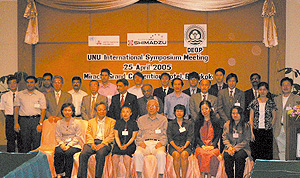
Dissemination activity at International Symposium
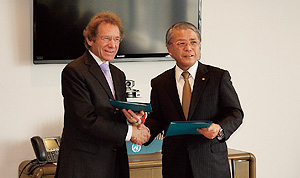
UNU Rector and Shimadzu President
formalized the agreement.
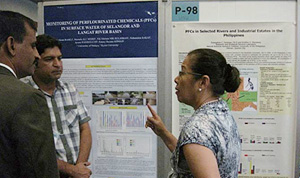
Poster presentation at a conference
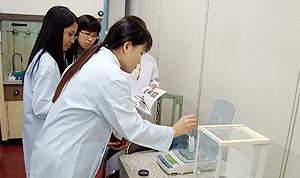
Technical Training Workshop
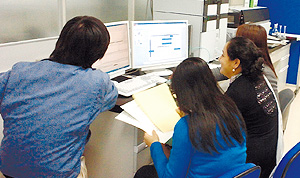
Technical Training Workshop
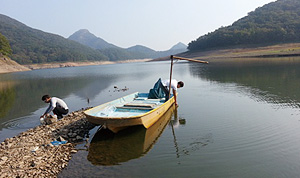
Sampling in a field (See Reference *)
Reference
* Photo provided by Chonnam National University, Republic of Korea


